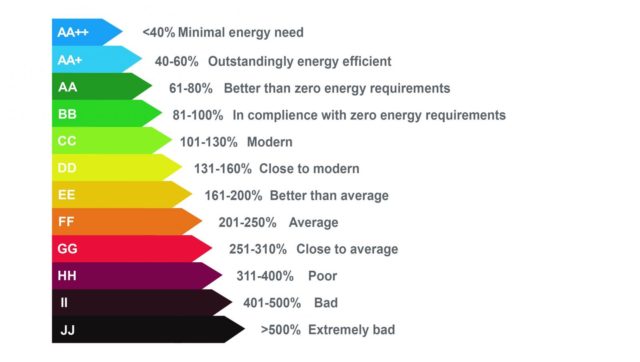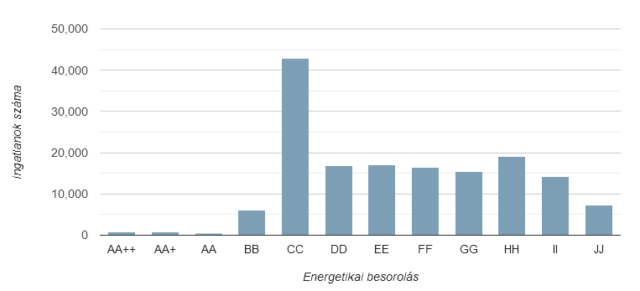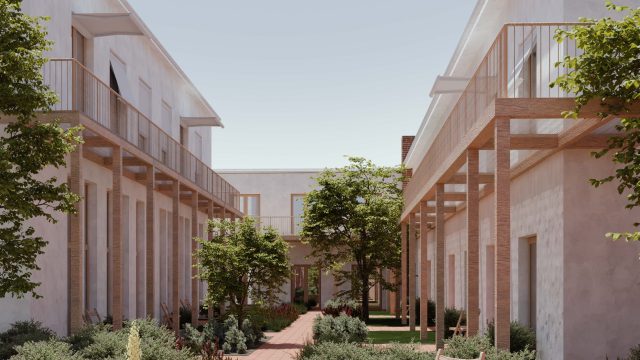What is the situation of the energy performance of domestic residential buildings in Hungary, how and with what results are the energy renovations of existing family and condominium buildings taking place? Fanni Sáfián, PhD of the Hungarian Energy Efficiency Institute (MEHI), based on the latest MEHI research results, joins the debate launched earlier by András Takács-Sánta.
Recently, András Takács-Sánta pointed out in a provocative article (Energy-efficient buildings: a seemingly green fallacy?) that technological progress and its application are in vain if consumers themselves are not conscious and moderate: the energy consumption and emission reductions saved often become victims of the rebound effect, and the overall picture is that the use of the Earth’s resources and the increase in emissions continue almost unabated.
The attention-grabbing article has since triggered a remarkable series of professional debates. Miklós Antal joined András in stressing that energy efficiency is not enough, but it is necessary to find a solution. He helped to orient readers on energy efficiency and the potential rebound effect it might have and reminded that energy efficiency can create win-win situations and that for it to be properly scaled up, it is essential that it is seen as a profitable solution for the economy.
The final contributor to the series of articles was László Szekér, who pointed out that, unfortunately, energy-efficient buildings are often only on paper: a design, a high-performance building, is often a shadow of its original vision by the time it reaches the implementation stage. “A similar ‘performance gap’ can be observed in the field of energy efficiency: we are insulating, replacing windows and windowsills, even upgrading heating, yet energy consumption is not reduced. What are the causes of the performance gap?” As colleagues of the Hungarian Institute for Energy Efficiency, we have been looking into these questions in recent years: what is the situation of the energy performance of domestic residential buildings in Hungary, how and with what results are the energy renovations of existing family houses and apartment buildings taking place? We would therefore like to contribute to this valuable exchange of views with our latest research results and – to move towards practical solutions – with some suggestions for improving the energy efficiency of our residential buildings.
First of all, we would like to clarify that what follows is about the energy renovation of existing family houses and apartment buildings. The reason for this is that – although the mandatory near-zero energy performance standard for new residential buildings has inexplicably been postponed until 30 June 2022 – new buildings have to meet fundamentally high standards, so there is a difference of magnitude between the energy consumption of new and existing buildings – and it is the latter that will be the focus of the following discussion.
In Hungary there are about 4.5 million dwellings in nearly 3 million buildings, of which less than 4 million are occupied. About 95% of these buildings are detached houses, of which nearly ¾ were built before 1980 to the very low thermal standards of that period, and a significant proportion of these have not been upgraded. While 10-20 thousand new dwellings are built every year, 100-130 thousand of the existing ones would need to be renovated every year to bring the domestic housing sector up to energy efficiency standards by 2050.
Why is this so important? Around 40% of final energy consumption in the country is related to buildings, one third to households. So this means that our residential buildings are one of the biggest energy-consuming sectors, without renewing them we have no chance of getting the country close to the climate neutrality target by 2050. To make a big step forward, it is clear where we need to focus: 72% of final energy use in households is for heating, and 85% for hot water (based on 2020 MEKH data). Reducing heating energy demand must therefore be a priority, and this can be achieved primarily through energy efficiency measures: insulation, replacement of windows and doors and modernisation of heating systems.
But these energy efficiency renovations are going on all the time! – you could say, referring to the news and the many houses and prefabricated buildings under renovation. However, it’s all in the details, and based on previous surveys, we were unfortunately aware that although the energy renovation rate in Hungary is not below the European average, it is mainly partial renovations that dominate, rather than complex, so-called deep renovations. While energy savings of 10-30% can usually be achieved through individual measures, deep renovations aim to fully exploit the savings potential of the building, achieving energy savings of up to 60-80%, while creating more comfortable, warmer and healthier homes. The recently published Long-Term Renewal Strategy (2021) has set a target of 90% near-zero energy buildings by 2050. However, we are still a long way from that target: based on 2020 data, 63% of detached houses and 52-77% of apartment buildings are not yet partially or not at all insulated.
A more nuanced picture of the energy situation of the domestic building stock can be obtained by looking at their energy certificates. Since 2009, these have been mandatory for all apartments or houses for sale or rent. These certificates calculate the energy consumption of the building or dwelling on the basis of an energy assessment and classify it into the following categories, marked with double letters:

There are huge differences in energy consumption between the 11 categories: if we take the energy consumption of 100 kWh per square metre at the border between BB and CC as 100% (the percentages in the table can therefore be equated to 1 kWh/m2/year), compared to a BB building, a building in the same category AA++ would use less than half as much energy, a FF more than twice as much, while a JJ more than five times as much energy (gas, firewood, coal, etc. ) to provide the same warmth in the same home. In Hungary, between 2013 and 2015, most certificates were issued for FF (201-250%), i.e. average buildings, and only from 2016 onwards did the CC (101-130%), i.e. modern category become the most common – while even in 2020, almost half of the certificates, 46%, were still in the FF-JJ (201-501<%) categories[1]. Remember, these figures are mainly for buildings that have been put up for sale, with an over-representation of new and renovated buildings – so the energy waste is staggering.

From category BB upwards, we can talk about buildings with almost zero energy demand, with an annual energy demand below 100 kWh/m2/year, but currently only a fraction of the other categories: in 2020, for example, less than 5% of the nearly 160,000 certificates completed were BB, AA or AA+.
Taking a positive approach, the energy saving potential of the domestic housing stock is huge, as the energy demand of an average home could be at least halved through energy efficiency investments. From the above data, we have seen that there are many buildings still to be upgraded, while every year many homes are undergoing some form of energy efficiency investment.
At MEHI, we were very curious to see what these energy efficiency upgrades look like in Hungary, and whether we can expect to make substantial progress towards the domestic targets by multiplying their number. In order to get an accurate picture of the situation, we conducted a nationally representative residential survey at the end of 2020 to find out what residential energy efficiency upgrades have been made in the last 5 years and why, and asked respondents about their plans for the next 5 years.
We were really surprised to find that the results showed that 57% of all respondents had made some energy efficiency upgrades in the last 5 years. This is a high number in itself, but even more so compared to the results of our previous survey, when in 2016, 24% of respondents planned to invest in energy efficiency for the period 2016-2020. That’s unfortunately as far as the good news goes, let’s look at the details.
For all three types of measures (insulation, heating upgrades, window replacement), the main reason for renovation was that older equipment or elements were broken, damaged, in poor condition or outdated. This was followed by improving comfort and reducing utility bills as targets, but to a much lesser extent – so most investments were addressing an acute problem rather than being part of a considered, planned investment. Energy efficiency was not even considered as an aspect in most cases. This is confirmed by the following figures:
- 76% of energy upgrades are partial, single-item investments – a far cry from deep renovations and exploiting energy saving potential;
- 76% of upgrades are also carried out without technical energy design;
- Partly as a consequence of this, while 93% of renovators consider the investment to have been worthwhile, only 48%, or less than half of renovators, cite lower energy bills as a reason.
Based on the above, a picture of domestic energy renovations is emerging, which basically means the ad-hoc, fire-fighting replacement or repair of building elements and machinery that can no longer be postponed and that are broken or failing in a way that hinders everyday life, mostly according to the ideas of the owner, or perhaps neighbours, friends or the contractor. Thus, only 15-30% of energy upgrades are carried out with a specific energy efficiency objective and only 24% involve at least two of the three elements (insulation, heating upgrading, replacement of windows and doors). Unfortunately, the results show that, as a consequence, not only is the energy efficiency potential of the building not being exploited, but a mass of renovations with particularly harmful results (mould, thermal bridges, inability to upgrade additional elements) and a mass of technological lock-in is being experienced.
A lock-in effect occurs when an infrastructure upgrade or investment, which is relatively expensive and rarely carried out, is carried out in a sub-optimal way, i.e. does not exploit the maximum savings potential. As a result, it locks in, almost literally embeds, in the case of buildings, outdated, energy-wasting or even unhealthy technology for the next 10-20 or even 30 years. Unfortunately, the number of bad examples of energy renovation is endless, the main causes being lack of information, lack of forethought, hasty solutions, investments without specialists or expertise, and above all, a lack of savings, long-term thinking and financial problems. Thus, while the insulation material itself represents only a small part of the investment cost of a thermal insulation project, renovators often try to save on the thickness of the insulation, thus missing out on potential energy savings or on other aspects: they are paying for an investment that will guarantee high energy bills for the next 20-30 years, when the renovation itself could have been a golden opportunity to ensure that their home is economical, comfortable and environmentally friendly for decades to come. All other investments are practically a waste of money, but unfortunately we see renovations where 5-6 cm of insulation is put on the walls; old double-glazed windows are replaced by old, dismantled ones bought from a friend; or the same type of boiler is replaced by a broken one, while there are much more efficient ones on the market. And families feel they have saved cleverly, without realising that if they had spent just a little more on renovation, their energy bills could have been 40-60% lower over the next 20-30 years, and that would have been the real saving[2].
To put some numbers on the above: for the Kádár Cubes, which represent around 800,000 homes, we are talking about annual heating costs of up to 500-600 thousand HUF, so the annual savings would be in the order of 100,000 HUF. Based on the results of the survey, we estimate that between 2016 and 2020, renovators spent between HUF 2,500 and 3,000 billion on energy renovation in the above ways. And in the next 5 years, a further 1.4 million (!) households are planning some kind of energy retrofit – so there is a strong urgency to shift domestic renovation towards complex, engineering-based deep renovations that exploit energy saving potential. Without this, achieving domestic climate targets will be impossible, as homes that are being retrofitted now, in these years, may well not be re-insulated by 2050.
And what can bring the solution? We see the need for predictable, long-term, non-campaign public funding as inevitable. At the moment, subsidies are only available for certain groups, and subsidies for energy efficiency[3] – with energy-related, i.e. quality of outcome, i.e. savings, expectations – do not exist in the residential sector, and unfortunately, there is no sign of any such thinking among decision-makers. In the absence of this, what we can do is to raise awareness and address the lack of information, i.e. information and technical assistance. This year, the Hungarian Chamber of Engineers has launched free energy advice through the new National Energy Network, which is available online or in person to residents and small businesses. Another very exciting initiative is a one-stop-shop advisory system (RenoPont Energy Home Renovation Centre, see this previous article) currently being developed under an EU project (RenoHUb), where prospective renovators can get all technical, financial and legal information, templates from design to construction, guarantees and tendering opportunities in one place. The service also recommends reliable, assessed professionals and, in the case of more substantial packages, can even take on the full management of the renovation work, i.e. turnkey implementation. The consortium of Hungarian professional organisations (including MEHI) has already opened the first RenoPont office test run in Nagykanizsa, and is currently developing the Budapest office and a highly detailed online information platform. We very much hope that this will help to increase the real energy efficiency of domestic residential buildings and the energy awareness of their occupants!

